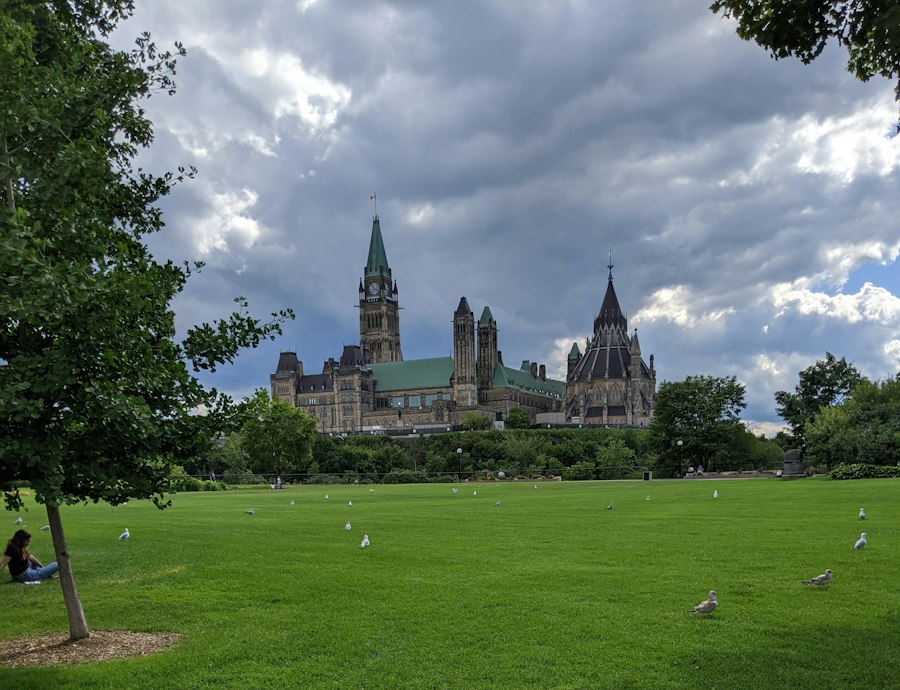Ottawa, the capital city of Canada, has a rich architectural history that has shaped its identity over the years. From its early days as a small lumber town to its current status as a thriving metropolis, Ottawa’s architecture reflects the city’s growth and development. The buildings in Ottawa tell a story of the city’s past, present, and future, and play a crucial role in defining its character.
Architecture is more than just buildings; it is an art form that reflects the values, aspirations, and culture of a society. In the case of Ottawa, architecture has played a significant role in shaping the city’s identity. The various architectural styles that have emerged throughout Ottawa’s history have left an indelible mark on the cityscape, creating a unique and diverse architectural landscape.
Key Takeaways
- Gothic Revival architecture rose in popularity in Ottawa during the mid-19th century, with notable examples including the Parliament Buildings and the Notre-Dame Cathedral Basilica.
- Victorian architecture heavily influenced Ottawa’s design, with many buildings featuring ornate details and decorative elements such as turrets and gables.
- Art Deco emerged in Ottawa during the 1920s and 1930s, with notable examples including the Chateau Laurier and the Mayfair Theatre.
- Ottawa’s post-war modernist movement saw the construction of many government buildings and high-rise apartments, with a focus on functionality and simplicity.
- Brutalist architecture gained popularity in Ottawa during the 1960s and 1970s, with notable examples including the National Gallery of Canada and the Carleton University Library.
- Sustainable design has become increasingly integrated into Ottawa’s architecture, with many new buildings featuring green roofs, solar panels, and other eco-friendly features.
- Postmodernism had a significant impact on Ottawa’s architectural landscape during the 1980s and 1990s, with buildings such as the Canadian Museum of Civilization featuring playful and eclectic designs.
- Contemporary architecture in Ottawa blends traditional and innovative elements, with notable examples including the Ottawa Art Gallery and the Rideau Centre expansion.
- Public art plays an important role in Ottawa’s architectural identity, with many buildings featuring sculptures, murals, and other artistic installations.
- The future of Ottawa’s architecture will require a balance between growth and preservation, with a focus on sustainable design and the integration of new buildings into the city’s existing urban fabric.
The Rise of Gothic Revival Architecture in Ottawa
Gothic Revival architecture gained popularity in the 19th century as a reaction against the industrialization and urbanization of cities. It sought to revive the architectural styles of medieval Europe, with their pointed arches, ribbed vaults, and ornate detailing. In Ottawa, Gothic Revival architecture became prominent during the mid-19th century and can be seen in many of the city’s historic buildings.
One of the most iconic examples of Gothic Revival architecture in Ottawa is the Parliament Hill complex. Designed by architect Thomas Fuller and completed in 1867, the Parliament Buildings are characterized by their dramatic spires, pointed arches, and intricate stone carvings. The Parliament Buildings are not only a symbol of Canada’s democracy but also a testament to the enduring legacy of Gothic Revival architecture in Ottawa.
The significance of Gothic Revival architecture in Ottawa’s architectural landscape cannot be overstated. It not only added a sense of grandeur and elegance to the city but also helped establish Ottawa as an important political and cultural center. The use of Gothic Revival architecture in public buildings, such as churches, government buildings, and universities, created a sense of continuity and tradition that is still evident in Ottawa’s architectural fabric today.
The Influence of Victorian Architecture in Ottawa’s Design
Victorian architecture, which emerged during the reign of Queen Victoria in the 19th century, is characterized by its ornate detailing, eclectic mix of styles, and emphasis on craftsmanship. In Ottawa, Victorian architecture played a significant role in shaping the city’s design and can be seen in many of its historic neighborhoods and buildings.
One notable example of Victorian architecture in Ottawa is the Rideau Hall, the official residence of the Governor General of Canada. Built in the mid-19th century, Rideau Hall showcases the grandeur and opulence of Victorian design with its intricate woodwork, decorative plasterwork, and elaborate gardens. The building’s design reflects the aspirations of the time and serves as a reminder of Ottawa’s rich architectural heritage.
Victorian architecture influenced Ottawa’s design by introducing new architectural styles and construction techniques. The use of ornate detailing and eclectic mix of styles added a sense of richness and diversity to the city’s architectural landscape. Victorian buildings can be found throughout Ottawa, from residential homes to commercial buildings, contributing to the city’s unique character.
The Emergence of Art Deco in Ottawa’s Architecture
Art Deco architecture emerged in the early 20th century as a response to the rapid industrialization and technological advancements of the time. It is characterized by its geometric shapes, streamlined forms, and decorative motifs. In Ottawa, Art Deco architecture became popular during the 1920s and 1930s and can be seen in many of the city’s iconic buildings.
One notable example of Art Deco architecture in Ottawa is the Château Laurier hotel. Designed by architects Ross and MacFarlane and completed in 1912, the Château Laurier is a prime example of the Art Deco style with its symmetrical façade, decorative detailing, and use of materials such as limestone and copper. The hotel’s design reflects the elegance and sophistication of the Art Deco era and has become an iconic landmark in Ottawa.
The significance of Art Deco architecture in Ottawa’s architectural landscape lies in its contribution to the city’s modernization and urbanization. The use of geometric shapes and streamlined forms added a sense of dynamism and progress to the city’s design. Art Deco buildings can be found throughout Ottawa, from commercial buildings to residential homes, showcasing the city’s embrace of modernity.
Ottawa’s Post-War Modernist Movement
The post-war period in Ottawa saw a shift towards modernist architecture, which emphasized functionality, simplicity, and the use of new materials such as glass and steel. This architectural style emerged as a response to the destruction caused by World War II and the need for affordable and efficient housing. In Ottawa, post-war modernist architecture became prominent during the 1950s and 1960s and can be seen in many of the city’s institutional buildings.
One notable example of post-war modernist architecture in Ottawa is the National Arts Centre. Designed by architect Fred Lebensold and completed in 1969, the National Arts Centre is characterized by its clean lines, minimalist aesthetic, and use of concrete. The building’s design reflects the ideals of the post-war period, with its focus on functionality and efficiency.
The significance of post-war modernist architecture in Ottawa’s architectural landscape lies in its contribution to the city’s urban development and infrastructure. The use of new materials and construction techniques allowed for the construction of large-scale buildings that could accommodate the growing population. Post-war modernist buildings can be found throughout Ottawa, from government buildings to educational institutions, shaping the city’s modern identity.
The Evolution of Brutalist Architecture in Ottawa

Brutalist architecture emerged in the mid-20th century as a response to the social and political climate of the time. It is characterized by its use of raw concrete, bold geometric forms, and lack of decorative detailing. In Ottawa, Brutalist architecture became prominent during the 1960s and 1970s and can be seen in many of the city’s institutional buildings.
One notable example of Brutalist architecture in Ottawa is the National Gallery of Canada. Designed by architect Moshe Safdie and completed in 1988, the National Gallery is characterized by its massive concrete forms, angular shapes, and extensive use of glass. The building’s design reflects the ideals of Brutalism, with its emphasis on functionality and the use of raw materials.
The significance of Brutalist architecture in Ottawa’s architectural landscape lies in its contribution to the city’s cultural and artistic scene. The use of raw concrete and bold forms added a sense of drama and monumentality to the city’s design. Brutalist buildings can be found throughout Ottawa, from museums to libraries, shaping the city’s cultural identity.
The Integration of Sustainable Design in Ottawa’s Architecture
Sustainable design has become an increasingly important consideration in modern architecture, as cities around the world grapple with issues such as climate change and resource depletion. In Ottawa, sustainable design has been embraced as a way to create buildings that are environmentally friendly, energy-efficient, and socially responsible.
One notable example of sustainable design in Ottawa is the Canada Green Building Council headquarters. Designed by architect Barry Sampson and completed in 2012, the Canada Green Building Council headquarters is characterized by its use of renewable materials, energy-efficient systems, and green spaces. The building’s design reflects the principles of sustainable design, with its focus on minimizing environmental impact and promoting occupant well-being.
The integration of sustainable design in Ottawa’s architecture is significant because it demonstrates the city’s commitment to environmental stewardship and sustainable development. Sustainable buildings can be found throughout Ottawa, from residential homes to commercial buildings, contributing to the city’s reputation as a leader in sustainable design.
The Impact of Postmodernism on Ottawa’s Architectural Landscape
Postmodernism emerged in the late 20th century as a reaction against the perceived rigidity and uniformity of modernist architecture. It is characterized by its eclectic mix of styles, playful use of forms and materials, and emphasis on symbolism and ornamentation. In Ottawa, postmodern architecture became prominent during the 1980s and 1990s and can be seen in many of the city’s institutional and commercial buildings.
One notable example of postmodern architecture in Ottawa is the Canadian Museum of History. Designed by architect Douglas Cardinal and completed in 1989, the Canadian Museum of History is characterized by its curvilinear forms, vibrant colors, and use of indigenous motifs. The building’s design reflects the principles of postmodernism, with its emphasis on cultural diversity and inclusivity.
The significance of postmodernism in Ottawa’s architectural landscape lies in its contribution to the city’s cultural and artistic scene. The use of eclectic styles and playful forms added a sense of whimsy and creativity to the city’s design. Postmodern buildings can be found throughout Ottawa, from museums to commercial buildings, shaping the city’s cultural identity.
Ottawa’s Contemporary Architecture: A Fusion of Tradition and Innovation
Contemporary architecture is characterized by its emphasis on sustainability, innovation, and the integration of new technologies. In Ottawa, contemporary architecture has emerged as a fusion of tradition and innovation, blending the city’s rich architectural heritage with modern design principles.
One notable example of contemporary architecture in Ottawa is the National Holocaust Monument. Designed by architect Daniel Libeskind and completed in 2017, the National Holocaust Monument is characterized by its angular forms, reflective surfaces, and use of natural materials. The monument’s design reflects the principles of contemporary architecture, with its focus on sustainability and the use of innovative materials.
The significance of contemporary architecture in Ottawa’s architectural landscape lies in its ability to bridge the past and the future. Contemporary buildings can be found throughout Ottawa, from residential homes to cultural institutions, contributing to the city’s evolving architectural identity.
The Role of Public Art in Ottawa’s Architectural Identity
Public art plays a crucial role in shaping a city’s identity by adding beauty, vibrancy, and cultural significance to its architectural landscape. In Ottawa, public art has become an integral part of the city’s design, with numerous sculptures, murals, and installations scattered throughout its streets and public spaces.
One notable example of public art in Ottawa is the Maman sculpture by artist Louise Bourgeois. Located outside the National Gallery of Canada, Maman is a 30-foot-tall bronze sculpture of a spider that has become an iconic symbol of the city. The sculpture’s presence adds a sense of whimsy and intrigue to the city’s architectural landscape.
The importance of public art in Ottawa’s architectural identity lies in its ability to engage and inspire residents and visitors alike. Public art can be found throughout Ottawa, from parks to plazas, contributing to the city’s vibrant cultural scene.
The Future of Ottawa’s Architecture: Balancing Growth and Preservation
As Ottawa continues to grow and develop, it faces the challenge of balancing growth and preservation. The city must find ways to accommodate new development while preserving its architectural heritage and maintaining its unique character.
Preserving Ottawa’s architectural heritage is crucial because it allows future generations to appreciate and learn from the city’s past. It also helps create a sense of place and identity for residents and visitors alike. Strategies for preserving Ottawa’s architectural heritage include designating historic districts, providing incentives for heritage conservation, and promoting adaptive reuse of historic buildings.
At the same time, Ottawa must also accommodate new development and embrace innovative design principles. This can be achieved through sustainable design, which focuses on minimizing environmental impact and promoting occupant well-being. Strategies for accommodating growth include promoting density, encouraging mixed-use development, and integrating green spaces into the urban fabric.
Ottawa’s architectural history is a testament to the city’s growth, development, and cultural identity. From the Gothic Revival buildings of the 19th century to the contemporary designs of today, Ottawa’s architecture reflects the city’s past, present, and future.
Preserving and celebrating Ottawa’s architectural heritage is crucial because it allows us to appreciate the city’s history and cultural significance. At the same time, embracing innovative design principles and accommodating new development is necessary for the city’s continued growth and prosperity.
By balancing growth and preservation, Ottawa can ensure that its architectural landscape remains vibrant, diverse, and reflective of its unique character. As the city continues to evolve, it is important to remember the importance of architecture in shaping a city’s identity and to celebrate the buildings that make Ottawa truly special.
If you’re interested in Ottawa’s architectural journey, you might also enjoy reading this article on “Keep Pushing: Exploring the Boundaries of Modern Architecture.” It delves into the innovative designs and groundbreaking structures that have pushed the boundaries of architectural norms. From futuristic skyscrapers to eco-friendly buildings, this article showcases the evolution of architecture and how it has transformed cities around the world. Check it out here.








